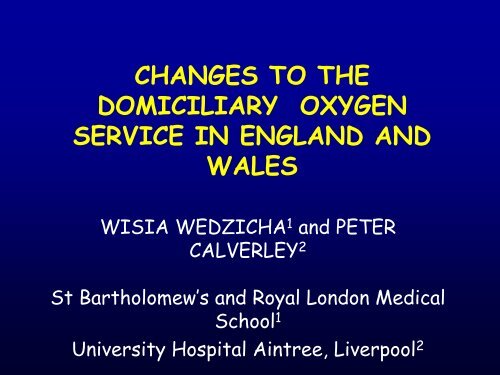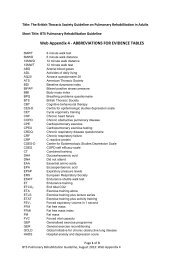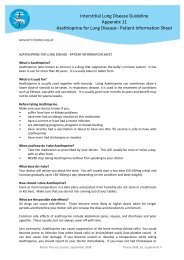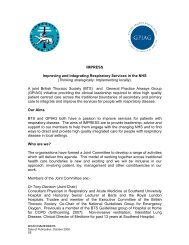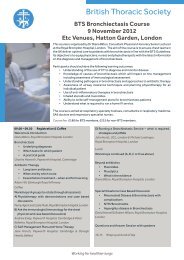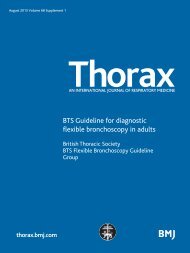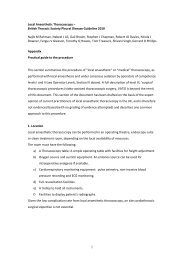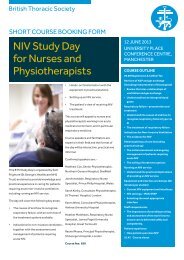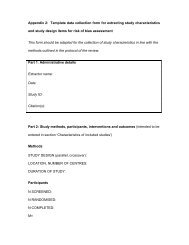clinical component of the domiciliary oxygen service ... - Brit Thoracic
clinical component of the domiciliary oxygen service ... - Brit Thoracic
clinical component of the domiciliary oxygen service ... - Brit Thoracic
- No tags were found...
You also want an ePaper? Increase the reach of your titles
YUMPU automatically turns print PDFs into web optimized ePapers that Google loves.
CHANGES TO THEDOMICILIARY OXYGENSERVICE IN ENGLAND ANDWALESWISIA WEDZICHA 1 and PETERCALVERLEY 2St Bartholomew’s and Royal London MedicalSchool 1University Hospital Aintree, Liverpool 2
WHY DO WE GIVE OXYGEN TOOUR PATIENTS?• To prolong life in <strong>the</strong> persistentlyhypoxaemic• To improve exercise performance• To reduce breathlessness acutely• To stop us worrying about <strong>the</strong> lowSaO2!
WHY DO WE GIVE OXYGEN TOOUR PATIENTS - THE EVIDENCE• To prolong life in <strong>the</strong> persistentlyhypoxaemic – GOOD IN COPD• To improve exercise performance – GOODACUTELY• To reduce breathlessness acutely -VARIABLE• To stop us worrying about <strong>the</strong> low SaO2 –BENEFIT FOR DOCTOR UNTESTED!
DOMICILIARY OXYGENTHERAPY• Long term Oxygen Therapy• Ambulatory Oxygen Therapy• Short Burst Oxygen Therapy• Temporary/Emergency OxygenTherapy
HISTORY OF OXYGEN SERVICE• Early 1980s - RCTs <strong>of</strong> LTOT published• 1985 - Oxygen concentrator <strong>service</strong>started• Lobbying for ambulatory <strong>oxygen</strong>• 1999 - RCP guidelines for home <strong>oxygen</strong>published• Various consultations/meetings• June 2003 - Ministers announce plans tomodernise home <strong>oxygen</strong> <strong>service</strong>• July 2003 - BTS Oxygen group reformed
CURRENT HOME OXYGENSERVICE• Primary Care prescriptions - <strong>of</strong>ten onsecondary care recommendation• Cylinder <strong>service</strong> - delivered/collected viapharmacists• Oxygen concentrator <strong>service</strong> -installed/maintained by specialistcompanies under contract - national <strong>service</strong>• Ambulatory <strong>oxygen</strong> not available onprescription• Different supply and payment routes
PROBLEMS WITH CURRENTSERVICE - RCP GUIDELINES• Secondary care not direct prescribers <strong>of</strong>home <strong>oxygen</strong> <strong>the</strong>rapy• Patients were not adequately assessed• Ambulatory <strong>oxygen</strong> provision variable andnot funded - liquid <strong>oxygen</strong> difficult toorganise• Follow up arrangements patchy
NEW SERVICE FROM OCT 2005• Respiratory specialist hospital assessmentand prescription• GPs will be able to prescribe - mainlypalliative/short burst• Ambulatory <strong>oxygen</strong> will be available onprescription• Integratedcylinder/concentrator/ambulatory <strong>service</strong>provided by one contractor• Funding will be devolved to PCTs for <strong>the</strong><strong>service</strong>.
CLINICAL ASSESSMENT ANDPRESCRIBING – KEY CHANGES• Changes reflect RCP guidelines and updated<strong>clinical</strong> standard document• Assessments to be performed in secondarycare – likely to be a team approach with aphysician lead• Oxygen needs assessed for ambulatory<strong>oxygen</strong>• Follow up arrangements to be defined• Proposal for separate ‘prescription’/order -discussions with PPA
BRITISH THORACIC SOCIETYWORKING PARTY ONDOMICILIARY OXYGENSERVICESWhat is it doing?
OBJECTIVES - BTS Oxygen Group• Write <strong>the</strong> <strong>clinical</strong> standard for assessmentand prescription <strong>of</strong> <strong>domiciliary</strong> <strong>oxygen</strong><strong>the</strong>rapy• Review <strong>the</strong> RCP guidelines to take intoaccount proposed changes and provision <strong>of</strong>ambulatory <strong>oxygen</strong> <strong>the</strong>rapy• Develop advice for follow up for patients• Produce revised version <strong>of</strong> DomiciliaryOxygen Record Form/prescription (DORform)• Education <strong>of</strong> health care pr<strong>of</strong>essionals
ASSESSMENT for LTOT• Referral to consultant respiratoryphysician• Confident <strong>clinical</strong> diagnosis• Optimum medical management and<strong>clinical</strong> stability - 5 weeks• Arterial blood gases - measuredtwice, at least 3 weeks apart
PRESCRIPTION AFTER HOSPITALADMISSION - “TEMPORARYOXYGEN”• LTOT prescription should be avoided onhospital discharge• Patients reviewed 5 weeks later• Temporary <strong>oxygen</strong> supply if required forhypoxaemia.• This supply should be discontinued whengases improve or LTOT prescribed
AMBULATORY OXYGEN THERAPYPRINCIPLES• Enables <strong>the</strong> patient to leave <strong>the</strong> home,improve daily activities and quality <strong>of</strong> life• Type <strong>of</strong> device depends on mobility• Many COPD patients spend little timeoutside <strong>the</strong> home - 50% <strong>of</strong> LTOT patientsare housebound• Prescribed in patients with LTOT PaO2
AMBULATORY OXYGEN THERAPY-PATIENT GRADING• GRADE 1 OXYGEN REQUIREMENTS -LTOT patients with low activity• GRADE 2 OXYGEN REQUIREMENTS -Mobile LTOT patients• GRADE 3 OXYGEN REQUIREMENTS -patients with exercise desaturation butnot on LTOT
AMBULATORY OXYGEN THERAPY-PATIENT ASSESSMENTASSESSMENT PERFORMED WILL DEPEND ONOXYGEN REQUIREMENTS• GRADE 1 OXYGEN REQUIREMENTS - Sameflow rate as for static source• GRADE 2 OXYGEN REQUIREMENTS - Evaluate<strong>oxygen</strong> flow rate to keep exercise SaO2 above90% using exercise test eg 6 minute walk• GRADE 3 OXYGEN REQUIREMENTS - Exercisetest required, performed on air and <strong>oxygen</strong>.Require evidence <strong>of</strong> exercise desaturation andimprovement with <strong>oxygen</strong>
SHORT BURST OXYGEN THERAPY• Pre-Oxygenation before exercise ?• Recovery from exercise?• Breathlessness at rest• Palliative care• After exacerbation - temporary<strong>oxygen</strong>ASSESSMENT - No specificmethodology
SHORT BURST OXYGEN THERAPY -who has it at home?• Hypoxaemic patients - should be on LTOT• Non-hypoxaemic patients - ei<strong>the</strong>r exercisedesaturators or non-desaturators• Palliative use• Heart failure• Information difficult to obtain onprescription
PATIENT FOLLOW UP• SPECIALISTAT 3 months after prescription and yearlyReassessment if undercorrection or deteriorationin symptoms• AT HOMEVisit within 4 weeks <strong>of</strong> prescriptionSix monthly visitsCheck on usage <strong>of</strong> ambulatory <strong>oxygen</strong> <strong>the</strong>rapy
PATIENT FOLLOW UP - PURPOSE• Record SaO2 on air and <strong>oxygen</strong>• Check <strong>oxygen</strong> usage - static and ambulatory• Check correct location <strong>of</strong> equipment, appropriatenasal cannulae and masks available• Provide contact details for <strong>oxygen</strong> supplier andrespiratory nurse/physio<strong>the</strong>rapist/technician• Reinforce non-smoking• Education and support• Complete Domiciliary Oxygen Record
ROLE OF OXYGEN CONTRACTOR• Deliver and maintain integrated <strong>service</strong>direct to patients on a 24 hour 7 days aweek basis - response times set• Decide <strong>the</strong> best way to supply <strong>oxygen</strong> tomeet patient’s needs• Apply technical expertise to developtechnologies• Contract requires new technologies to bepassed on to patients• Contractor required to engage in patientinvolvement/audit and information oncomplaints
Patient/Carer perspective - <strong>the</strong>plus side• Access to wide range <strong>of</strong> <strong>oxygen</strong><strong>service</strong>s• Patient does not need to return to GPfor <strong>oxygen</strong> prescription• Single supplier for all <strong>oxygen</strong> needs• Contractors will have to show patientinvolvement• Assessment and follow up included
CONTRACT AREAS• North West• North East• Yorkshire andHumberside• East Midlands• West Midlands• Wales• Eastern England• SW London,Thames Valley,Hants, IOW• SE London, Kent,Surrey and Sussex• London North• South West
ORGANISATION OF SERVICECONTRACT• Each <strong>service</strong> contract on regional basis - 3 SHAsper <strong>oxygen</strong> region• PCT deals with one contractor• PCT will need to obtain cylinder data to pass on tonew contractor• End <strong>of</strong> contract with pharmacists• Transitional arrangements• Funding transferred to PCT unified budgets• Streamlined payment system - proposed throughPPA as for current <strong>service</strong>• Monitoring performance and quality <strong>of</strong> <strong>service</strong>
TIMETABLE THUS FAR• June 2003 - Ministers announce new plans• July 2003 - BTS Oxygen group reformed• August – October 03 - meetings/paperwork• November 2003 - stakeholder meeting• Dec 03- May 2004 - work on draft contract• May 2004 - invitation for expressions <strong>of</strong>interest in tendering for <strong>service</strong> advertised• July 2004 - tenders invited• Nov 2004 - tender bids received
TIMETABLE 2005• Jan 2005 - recommendations to ministers• Feb 2005 - ministers announce contractors• Feb 2005 - Sep 2005 – implementation• Oct 2005 - Contract start date for O2<strong>service</strong>
MANAGING SERVICE CHANGE -TRANSITIONAL PERIOD• EDUCATION/PUBLICITY PROGRAMME!• PCT need to get <strong>the</strong>mselves organised• Contractors need 9 months to prepare for changeat agreed contract date• Information provided by PCT to contractor - easyfor concentrators - problematical for cylinders• Dialogue between PCTs, GPs and Trusts aboutassessment and prescription <strong>of</strong> O2 –<strong>the</strong> role <strong>of</strong><strong>the</strong> SHA’s• Start assessments for ambulatory <strong>oxygen</strong> ( MobileLTOT patients first)• Systems for managing and funding <strong>service</strong>
WHAT SHOULD THE CONSULTANTRESPIRATORY PHYSICIAN DO NOW?• Contact <strong>the</strong> local PCT and ask for a meeting <strong>of</strong> allthose interested in home <strong>oxygen</strong> <strong>the</strong>rapy• Review in house assessment protocols for bothLTOT and ambulatory <strong>oxygen</strong>• BTS Clinical Standard document available on <strong>the</strong>Web.• Work out how follow up will be organised withPCTs. Discuss with local BS-SHA rep any problems• Disseminate knowledge about home <strong>oxygen</strong><strong>the</strong>rapy


